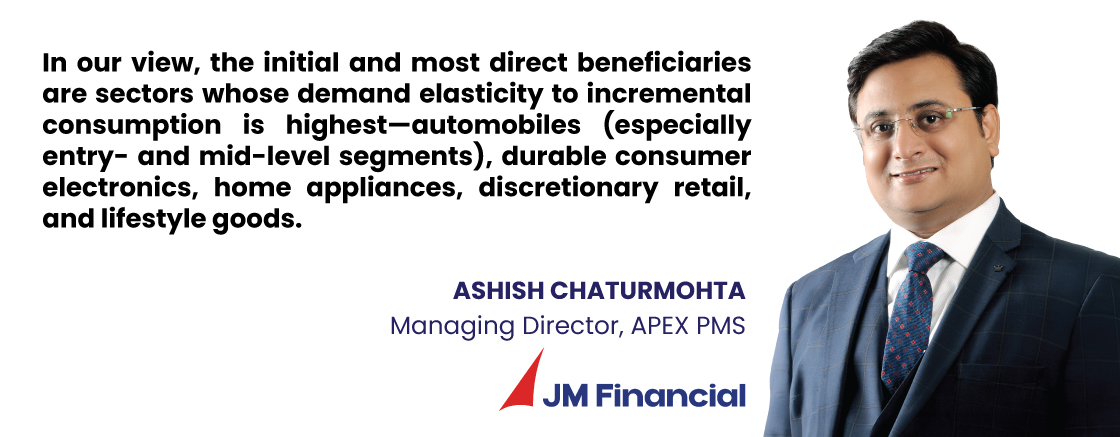This article is authored by Ashish Chaturmohta, Managing Director, APEX PMS, JM Financial Ltd.

The recent policy tilt toward consumption-led growth represents a decisive shift in India’s economic trajectory. A combination of income tax relief, GST rationalization, steps by the RBI (repo rate cuts), and liquidity infusion via CRR cuts is expected to meaningfully revive household demand from the second half of FY26. Together, these measures lay the foundation for a durable upcycle in consumption, especially benefiting sectors that are most sensitive to incremental spending by households.
An above-normal monsoon, 7 per cent above the long-term average, should reinforce rural sentiment and boost purchasing power in semi-urban and rural markets. This is complemented by monetary easing: the RBI, in its June 2025 Monetary Policy, cut the policy repo rate by 50 basis points to 5.50 %. Concurrently, the Cash Reserve Ratio (CRR) was reduced from ~4.0 % to 3.0 % (via a 100-bps cut), to be executed in phased steps. These cuts together are estimated to free up approximately ₹2.5 lakh crore of durable liquidity into the banking system.
On the fiscal side, the revision of income tax slabs is expected to release 6–10 % of household budgets, bolstering discretionary spending capacity. At the same time, GST 2.0 has rationalized the earlier four-tier structure into largely two rates—5 % and 18 %—effectively lowering tax burdens across a breadth of mass-consumed goods. This rationalization is projected to inject nearly ₹2 lakh crore into the hands of consumers, enhancing liquidity and demand. Notably, 99 % of goods formerly in the 12 % bracket now fall at 5 %, and 90 % of items in the 28 % category have moved to 18 %, significantly easing tax burdens in daily consumption baskets.
The timing of these reforms is strategic: consumption constitutes nearly 60 % of India’s GDP, and after a period of moderate growth, stimulating demand is crucial. The GST rationalization effectively acts as a direct liquidity stimulus—especially for middle- and lower-income households, where marginal savings immediately translate into consumption. This push coincides with the festive season, a traditional peak in consumer spending across sectors like food, apparel, electronics, and automobiles. In states such as Gujarat, Rajasthan, Bihar, and West Bengal—where festivals like Navratri, Diwali, Durga Puja, and Chhath carry high retail significance—retailers and manufacturers have already responded. Price tags have been revised, and automobile firms are coupling GST cuts with festive incentives. Early channel checks in September 2025 point to robust consumer traction, with distributor confidence suggesting that demand momentum may carry well beyond the festival period.
Preferred Beneficiaries & Demand Transmission
The reforms and policy thrusts described above set the stage for a broad-based consumption revival. In our view, the initial and most direct beneficiaries are sectors whose demand elasticity to incremental consumption is highest—automobiles (especially entry- and mid-level segments), durable consumer electronics, home appliances, discretionary retail, and lifestyle goods. As households channel savings into big-ticket purchases like cars and appliances, the cascade effect is likely to flow into smaller discretionary categories such as apparel and foods, aided by operating leverage in these sectors.
Moreover, the recovery in durable goods demand has a multiplier effect: when a consumer buys a refrigerator, the ancillary demand for components, logistics, and after-sales services also rises, creating ripple effects across supply chains. Similarly, a rise in auto sales stimulates demand for parts, financing, and insurance. In this environment, consumption-oriented sectors are likely to lead, especially in semi-urban and rural markets, where a latent consumption base remains underpenetrated.
Risks to Watch
While the upside is substantial, several risks must be monitored closely. First, the government may face a revenue shortfall—estimated at ₹48,000 crore—from GST reductions, constraining its ability to sustain capital expenditure and countercyclical stimulus. Second, export-oriented firms may face near-term headwinds from tariff uncertainties or global slowdown, which could offset gains from domestic demand. Third, the execution of tax reforms and the new GST structure involve transition risks: input tax credit pass-through could weigh on margins in the near term.
Nevertheless, we believe most of these risks are transitory or manageable over the medium term. The structural thrust remains clear, and the execution challenges are known and likely to stabilize as reforms mature.
JM Financial Apex Portfolio Management Strategy
JM Financial’s Apex Portfolio Management Strategy is anchored in an FTPM-based flexi-cap framework, combining discipline, adaptability, and foresight. Its process integrates fundamentals with momentum and technical indicators, while keeping a sharp focus on high-quality businesses and management teams capable of delivering sustainable long-term growth. The strategy seeks to marry the science of investing—through rigorous financial analysis and quantitative filters—with the art of timing, intuition, and market psychology. The strategy is designed to generate both alpha and resilience. Its inherent flexibility allows rotation across market caps, sectors, and themes; simultaneously, tactical hedging is deployed in phases of volatility, event risk, or external turbulence to preserve capital and sustain performance in a complex, interconnected market environment.
Positioning Apex to Capture the Consumption Cycle
Given the backdrop, Apex is being positioned with a deliberate tilt toward the consumption resurgence, without compromising flexibility or risk controls. The strategy increasing exposure to consumption-oriented sectors—automobiles, consumer durables, electronics, retail, and discretionary services—while retaining scope for rotation across market caps, sectors, and themes as the cycle evolves. Tactical hedging (such as Nifty put options) will be used opportunistically in periods of stress or ahead of macro surprises. Quality remains non-negotiable: Apex will continue to anchor on businesses with strong balance sheets, sustainable return-on-equity (ROE), pricing power, and capable management teams. The portfolio will seek to adapt dynamically—upsizing in high-alpha areas when conviction is strong, and trimming or hedging when the risk-reward tilts adverse.
In essence, Apex is not making a blanket bet on consumption—it is creating a strategic overweight while preserving agility to pivot if macro or market signals evolve differently.
Conclusion
India appears poised for a sustained consumption revival, driven by tax reforms, liquidity infusion, fiscal incentives, and policy support from the RBI. With the repo rate now at 5.50 % and CRR being cut to 3.0 %, the monetary environment is becoming more growth-friendly, freeing up capital for credit expansion and consumer financing. These macro moves, combined with structural reforms, align well with apex’s investment philosophy.
Apex’s flexi-cap framework, coupled with tactical hedging and quality discipline, is designed to benefit from the upswing in domestic demand while actively managing downside. For investors looking to participate in India’s consumption-led growth in a prudent, risk-aware way, Apex presents a compelling approach.
Disclaimer:
The views expressed are solely those of the author and do not represent PMS Bazaar’s views. This article is for information only and not investment advice. Investments are subject to market risks; investors should consult their advisors before investing.
*Please refer to the Disclosure Document and PMS Agreement for other details and associated risk disclosure
To view the detailed AMC Disclaimer, kindly CLICK HERE
Recent Blogs

Long-Only AIFs Rebound Sharply in October; Long-Short Strategies Lag Despite Lower Volatility
106 long-only AIFs averaged 3.68% vs 32 long-short AIFs at 2.7%; only 24–31% of funds beat key indices

Markets log strongest monthly gains in 7 months; PMS performance turns near-uniform in October
Nifty 50 TRI gained 4.62%, BSE 500 TRI rose 4.27%; 415 of 427 equity PMSes ended positive

How SMEs are Shaping India’s Investment Landscape?
PMS Bazaar recently organized a webinar titled “How SMEs are Shaping India’s Investment Landscape?” which featured Mr. Shrikant Goyal, Fund Manager, GetFive Opportunity Fund.

Stable Income from Indian REITs and InvITs
PMS Bazaar recently organized a webinar titled “Stable Income from Indian REITs and InvITs,” which featured Mr. Rahul Jain, Head of Public Markets, Alt.

5 Key Considerations Before Investing in AIFs in India
Alternative Investment Funds (AIFs) have emerged as a compelling option for sophisticated investors seeking diversification and potentially superior returns. But venturing into AIFs requires a clear understanding of their unique characteristics that go beyond simply knowing what they are and their categories.

How AIF can help in diversification?
Traditionally, Indian investors have relied on a mix of stocks and bonds to build their wealth. While this approach offers diversification, it can still leave your portfolio vulnerable to market fluctuations. Enter Alternative Investment Funds (AIFs), a dynamic asset class gaining traction for its ability to unlock diversification beyond the realm of conventional options.

Long-Short AIFs Outperform Again Even as Markets Rebound in September
104 long-only funds shows an average monthly gain of just 0.37 per cent, while long-short AIF category averaged 0.94 per cent

Resilience returns as markets rebound in September; Multi-asset PMSes lead pack
Over 63% of equity PMSes ended September in green; nearly two-thirds outperformed key benchmarks.

